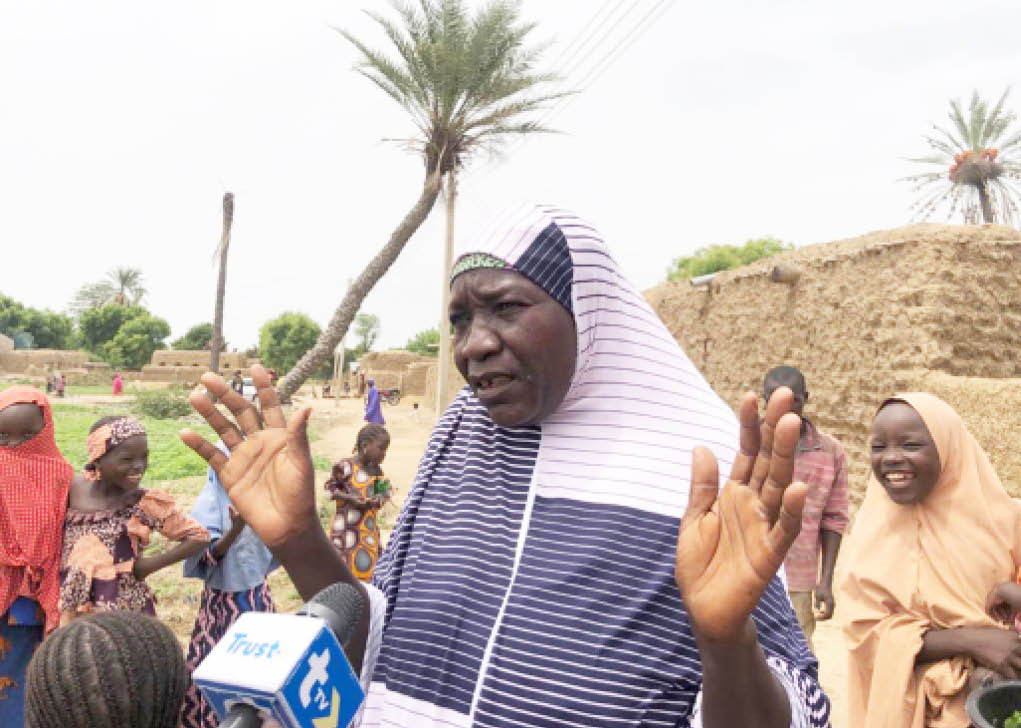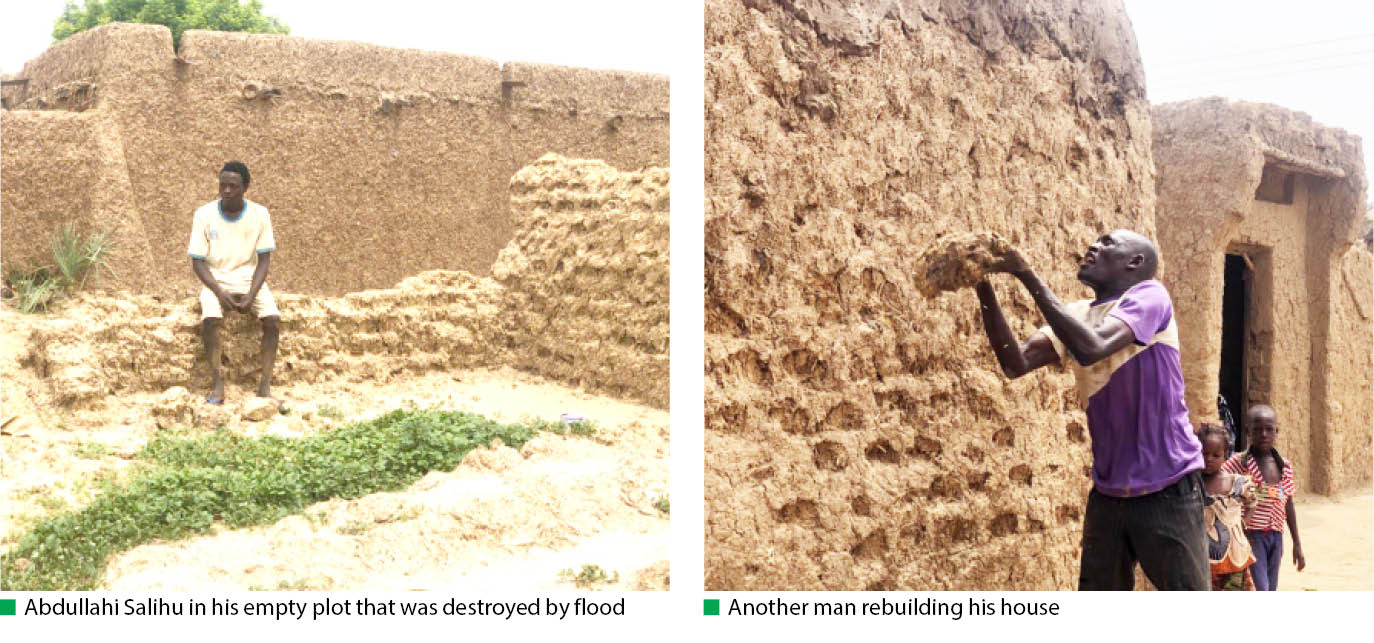Flood: Despite warnings, Jigawa communities rebuild houses destroyed in 2022
The Ministry of Humanitarian Affairs, Disaster Management and Social Development said Jigawa was the most affected state by the flood disaster…

Malama Mari Mai Gari
Malam Yahaya Lawan, a resident of Gudito village in Auyo Local Government Area of Jigawa State, was busy mixing clay sand with water to complete the remaining part of his two-room house which was destroyed by flood last year. At 64, he was working alone as he had no financial strength to hire labourers for the job.
With sweat dripping down from his face, Lawan said there was no guarantee that the building, which was over 50 percent completed with thatched walls, would still be in existence in a few days to come as there were possibilities of another flood disaster in the community. He said the dangers his families were exposed to forced him to rebuild the mud house since he had no other place to stay.
“Members of my entire family are sleeping outside and majority of my children are females. I have few male children but they are not yet grown, as you can see. My wives had to squat in our neighbourhood while I stayed here. We have been in this situation for over 10 months. That is why I decided to rebuild the house with thatched walls. We were sleeping under the rain,” he said.
Lawan is one out of thousands of people that were displaced by last year’s most devastating flood in Jigawa State. Tenths of villages were sacked, while hundreds of farmlands were destroyed, exposing people in the affected places into a serious hunger. They were forced to migrate from their respective villages to seek shelter in other places that cannot accommodate 10 per cent of them, but they had to squat to save their lives.
- Plateau denies deaths of 1,000 cows to strange disease
- Tinubu’s house cleaning exercise: Who’s next?

Daily Trust on Sunday gathered that Hadjia Local Government and Auyo are most affected as they are located near the Hadejia dam. Some of the villages that had to relocate include Ganuwar Kuka, Aimun, Maskangari, Gudito, Ciromawa, among many others.
The Ministry of Humanitarian Affairs, Disaster Management and Social Development said Jigawa was the most affected state by the flood disaster that ravaged parts of Nigeria in 2022. The state government said the flood killed 134 persons while property worth over N1.5trillion were lost to the flood in that year in the state.
The state government, through the then deputy governor, Alhaji Umar Namadi, who is now the state governor, said the flood affected 272,189 people while 76,887 lost their houses, adding that some villages were completely destroyed and a local government totally cut away from the rest of the state by road.
Daily Trust on Sunday gathered that despite being familiar with the recurring floods in the state, the magnitude of destruction witnessed in last year’s flood shocked the state and evoked feelings of anxiety and sorrow among its residents. They said that during the period between mid-August and September 2022, the state faced one of the most devastating floods it had experienced in years.
“Last year’s flood will never escape from our memory. We have never witnessed a disaster like that. Our village was destroyed. We had to relocate to a place where we sleep on sand and with mosquitoes biting us. That time, we were not after our belongings. We were evacuated from this village using a canoe. All of us were crying. My father cannot even move as he has been sick for over a decade now, we had to carry him. As confused as we were then, some of us even forgot their children,” an aged woman of Maskan Gari village, Malama Mari Maigari said.
However, despite the warning by the National Emergency Management Agency (NEMA) urging residents of flood-prone communities to relocate to higher ground before the start of the flood season, some communities in Jigawa, particularly those near the Hadejia dam, seem to have disregarded the advice, which, according to them, is due to lack of alternatives.
When Daily Trust on Sunday visited some of the neighbouring villages to the Hadejia dam, some of them were sighted rebuilding their houses. While some were returning to their mud houses, others used thatched walls as they didn’t have money to afford mud buildings. Others said they switched to thatch so that if the flood comes, it would not hit them more than when they built with mud.
Abdullahi Salihu, a resident of Aimun village, said his marriage was postponed indefinitely as the flood washed away his newly built house. He said he didn’t know when he would marry as he did not have the resources to rebuild the house.
“The flood washed away my house when my wedding was three weeks away and I didn’t have the means to build another one. The marriage was postponed,” he said.
Villagers who spoke to Daily Trust on Sunday said they were not interested in relocating as they were battling with acute hunger, which forced them to take loans from farm input companies to invest in their farms.
“Do you know what it takes to leave your place of birth? Have you ever done that? Almost every year, we have to relocate, but it wasn’t easy. And that was just temporary; imagine how the permanent relocation would be. Who provided a place for us, did they build the houses for us?
“As you see us now, we are battling with food to eat. We didn’t get anything from the government. We collected loans from some companies and invested in dry season farming. That is what we are eating now. We have to pay the loan and also continue with the rainy season farming,” he said.
Speaking on their efforts to avert the flooding, the village head of Gudito, Ali Maigari said they spent N1million in an attempt to prevent water from entering their village but to no avail.
“We raised N1million last year and built an embankment that surrounded the whole village. But the water had to cross and forced us to leave the village. We regretted doing it; we should have used the money somewhere else. For this year, we don’t even have the energy to do that. This is not something we can do alone. The government must come in,” he said.
Although efforts to reach the authorities for comment on the disaster were not successful, the Jigawa State governor, Alhaji Umar Namadi, in a recent visit to Vice President Kashim Shettima, said they had dredged the Hadejia dam as one of the majors means adopted to prevent the flood.
The governor said the state government had been implementing the recommendations of a technical committee of experts set up to tackle the perennial flooding.
On preparations being made to check the impact of flooding in his state he said, “Flooding in Jigawa State is really a serious issue, and we are doing many things. We have set up a technical committee of experts and they are looking at it. In fact, they have submitted a report and part of the report we have started implementing. We have bought two excavators and Hadejia bought two excavators.
“As at today, we have been able to dredge a river about 36km and we have removed the typha grass. Part of the recommendations of the committee is that we should do some embankment in the flood-prone areas. For now, we have done more than 85km of embankment with 2.5m height and 4m thickness. The people are happy because something is being done to salvage the situation.”
